light SATURN SKY 2007 User Guide
[x] Cancel search | Manufacturer: SATURN, Model Year: 2007, Model line: SKY, Model: SATURN SKY 2007Pages: 384, PDF Size: 2.47 MB
Page 57 of 384
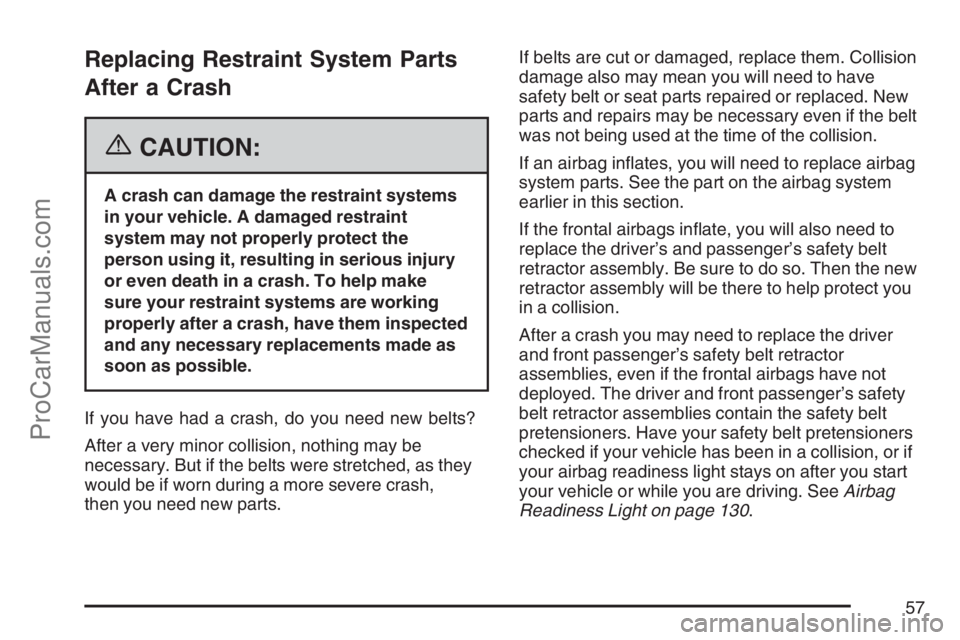
Replacing Restraint System Parts
After a Crash
{CAUTION:
A crash can damage the restraint systems
in your vehicle. A damaged restraint
system may not properly protect the
person using it, resulting in serious injury
or even death in a crash. To help make
sure your restraint systems are working
properly after a crash, have them inspected
and any necessary replacements made as
soon as possible.
If you have had a crash, do you need new belts?
After a very minor collision, nothing may be
necessary. But if the belts were stretched, as they
would be if worn during a more severe crash,
then you need new parts.If belts are cut or damaged, replace them. Collision
damage also may mean you will need to have
safety belt or seat parts repaired or replaced. New
parts and repairs may be necessary even if the belt
was not being used at the time of the collision.
If an airbag in�ates, you will need to replace airbag
system parts. See the part on the airbag system
earlier in this section.
If the frontal airbags in�ate, you will also need to
replace the driver’s and passenger’s safety belt
retractor assembly. Be sure to do so. Then the new
retractor assembly will be there to help protect you
in a collision.
After a crash you may need to replace the driver
and front passenger’s safety belt retractor
assemblies, even if the frontal airbags have not
deployed. The driver and front passenger’s safety
belt retractor assemblies contain the safety belt
pretensioners. Have your safety belt pretensioners
checked if your vehicle has been in a collision, or if
your airbag readiness light stays on after you start
your vehicle or while you are driving. SeeAirbag
Readiness Light on page 130.
57
ProCarManuals.com
Page 70 of 384
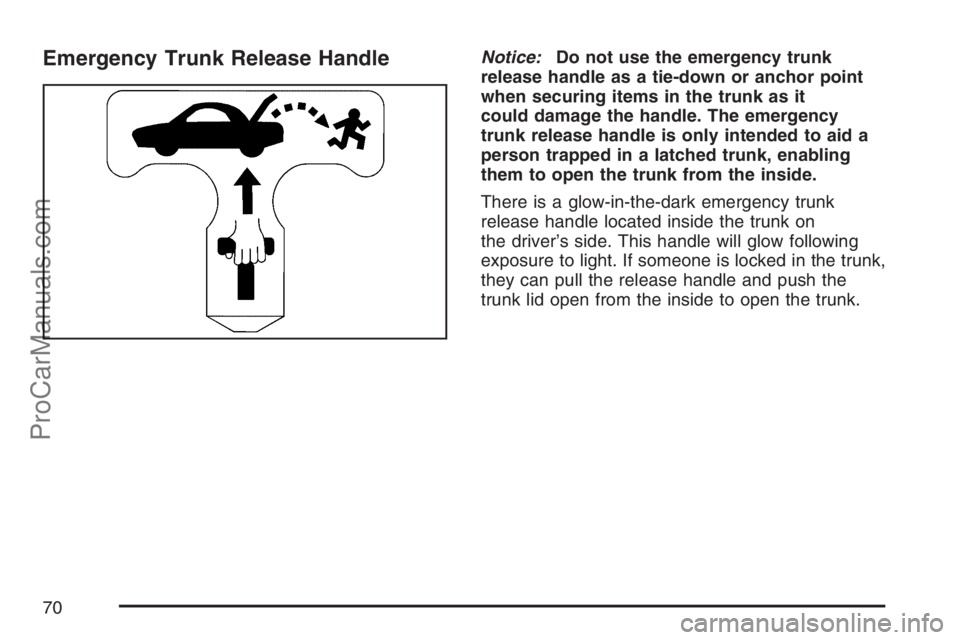
Emergency Trunk Release HandleNotice:Do not use the emergency trunk
release handle as a tie-down or anchor point
when securing items in the trunk as it
could damage the handle. The emergency
trunk release handle is only intended to aid a
person trapped in a latched trunk, enabling
them to open the trunk from the inside.
There is a glow-in-the-dark emergency trunk
release handle located inside the trunk on
the driver’s side. This handle will glow following
exposure to light. If someone is locked in the trunk,
they can pull the release handle and push the
trunk lid open from the inside to open the trunk.
70
ProCarManuals.com
Page 73 of 384

Theft-Deterrent Systems
Vehicle theft is big business, especially in some
cities. Although your vehicle has a number of
theft-deterrent features, we know that nothing we
put on it can make it impossible to steal.
Content Theft-Deterrent
Your vehicle may have a content theft-deterrent
alarm system.
The security light,
located on the
instrument panel cluster,
will turn on to indicate
that arming has
been initiated.
Once the system is armed, the security light will
�ash once every three seconds.
If the security light is �ashing twice per second,
this means that a door is open.
Arming the System
While the ignition is off, press the remote keyless
entry transmitter lock button, to arm the system.
The system will arm after either of these
things occur:
Thirty seconds after all the doors are closed.
Sixty seconds with any door open.
If you press the lock button on the transmitter a
second time while all the doors are closed,
the system will arm immediately. The system arms
in 60 seconds if a door is open, or after the
open door is closed.
If you do not want to arm the system, lock the car
with the manual door lock knobs.
Disarming the System
You can disarm the system by doing any one of
the following:
Press the unlock button on the remote keyless
entry transmitter.
Turn the ignition on.
73
ProCarManuals.com
Page 74 of 384

If the system is armed and the trunk is opened
using the trunk release button on the transmitter,
the system will temporarily disarm itself and re-arm
when the trunk has been closed. This allows you to
exit the vehicle, lock the doors using the transmitter,
or open the trunk using the transmitter without
having to disarm and re-arm the system.
Once the system is disarmed, the security light will
stop �ashing.
How the System Alarm is Activated
If the system is armed, it can be activated by:
Opening the driver’s door or trunk. This causes
a ten second pre-alarm chirping noise followed
by the horn sounding and lights �ashing for
30 seconds.
Opening a passenger’s door. This immediately
causes a full alarm of the horn sounding and
lights �ashing for 30 seconds.
After the 30 second alarm ends, the system will
re-arm itself.
How to Turn Off the System Alarm
To turn off the system alarm, do one of the
following:
Press the lock button on the remote keyless
entry transmitter. The system will then
re-arm itself.
Press the unlock button on the remote keyless
entry transmitter. This will also disarm the
system.
Insert the key in the ignition and turn it on.
This will also disarm the system.
How to Detect a Tamper Condition
If you hear three chirps when you press the
unlock, lock, or trunk release buttons on the
remote keyless transmitter, it means that
the content theft security system alarm was
activated previously.
74
ProCarManuals.com
Page 75 of 384
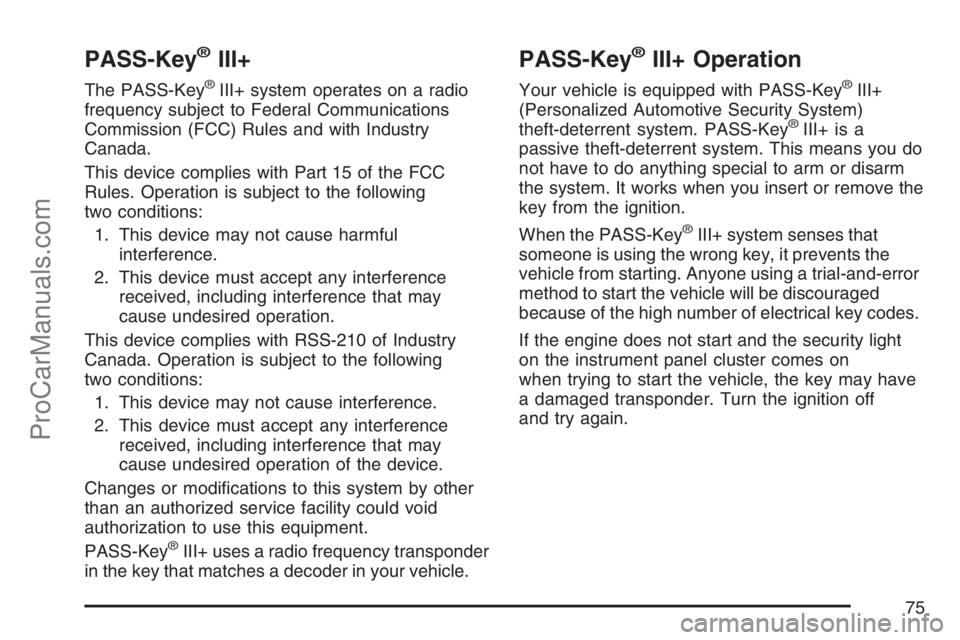
PASS-Key®III+
The PASS-Key®III+ system operates on a radio
frequency subject to Federal Communications
Commission (FCC) Rules and with Industry
Canada.
This device complies with Part 15 of the FCC
Rules. Operation is subject to the following
two conditions:
1. This device may not cause harmful
interference.
2. This device must accept any interference
received, including interference that may
cause undesired operation.
This device complies with RSS-210 of Industry
Canada. Operation is subject to the following
two conditions:
1. This device may not cause interference.
2. This device must accept any interference
received, including interference that may
cause undesired operation of the device.
Changes or modi�cations to this system by other
than an authorized service facility could void
authorization to use this equipment.
PASS-Key
®III+ uses a radio frequency transponder
in the key that matches a decoder in your vehicle.
PASS-Key®III+ Operation
Your vehicle is equipped with PASS-Key®III+
(Personalized Automotive Security System)
theft-deterrent system. PASS-Key
®III+ is a
passive theft-deterrent system. This means you do
not have to do anything special to arm or disarm
the system. It works when you insert or remove the
key from the ignition.
When the PASS-Key
®III+ system senses that
someone is using the wrong key, it prevents the
vehicle from starting. Anyone using a trial-and-error
method to start the vehicle will be discouraged
because of the high number of electrical key codes.
If the engine does not start and the security light
on the instrument panel cluster comes on
when trying to start the vehicle, the key may have
a damaged transponder. Turn the ignition off
and try again.
75
ProCarManuals.com
Page 76 of 384
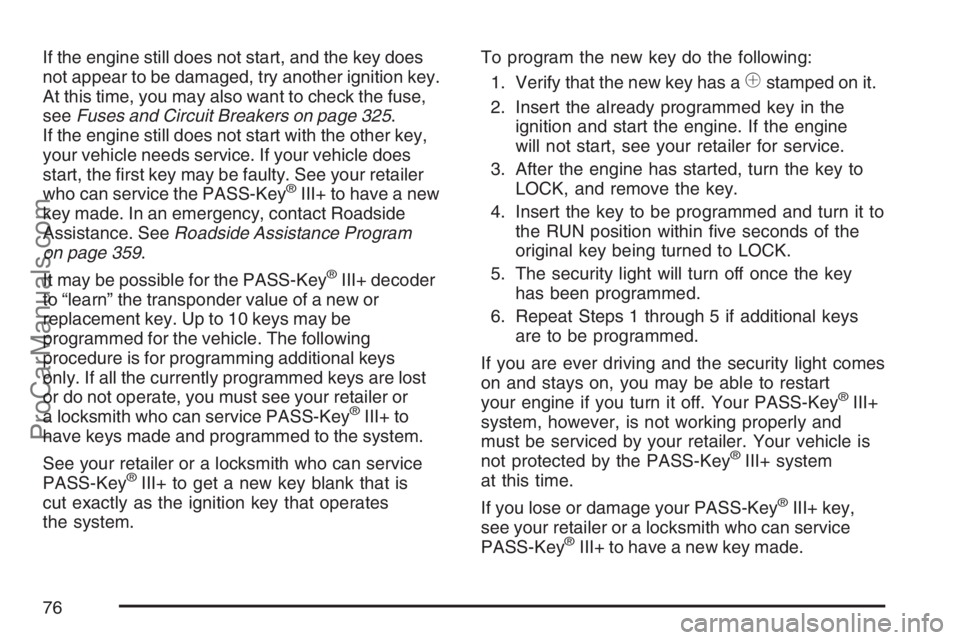
If the engine still does not start, and the key does
not appear to be damaged, try another ignition key.
At this time, you may also want to check the fuse,
seeFuses and Circuit Breakers on page 325.
If the engine still does not start with the other key,
your vehicle needs service. If your vehicle does
start, the �rst key may be faulty. See your retailer
who can service the PASS-Key
®III+ to have a new
key made. In an emergency, contact Roadside
Assistance. SeeRoadside Assistance Program
on page 359.
It may be possible for the PASS-Key
®III+ decoder
to “learn” the transponder value of a new or
replacement key. Up to 10 keys may be
programmed for the vehicle. The following
procedure is for programming additional keys
only. If all the currently programmed keys are lost
or do not operate, you must see your retailer or
a locksmith who can service PASS-Key
®III+ to
have keys made and programmed to the system.
See your retailer or a locksmith who can service
PASS-Key
®III+ to get a new key blank that is
cut exactly as the ignition key that operates
the system.To program the new key do the following:
1. Verify that the new key has a
1stamped on it.
2. Insert the already programmed key in the
ignition and start the engine. If the engine
will not start, see your retailer for service.
3. After the engine has started, turn the key to
LOCK, and remove the key.
4. Insert the key to be programmed and turn it to
the RUN position within �ve seconds of the
original key being turned to LOCK.
5. The security light will turn off once the key
has been programmed.
6. Repeat Steps 1 through 5 if additional keys
are to be programmed.
If you are ever driving and the security light comes
on and stays on, you may be able to restart
your engine if you turn it off. Your PASS-Key
®III+
system, however, is not working properly and
must be serviced by your retailer. Your vehicle is
not protected by the PASS-Key
®III+ system
at this time.
If you lose or damage your PASS-Key
®III+ key,
see your retailer or a locksmith who can service
PASS-Key
®III+ to have a new key made.
76
ProCarManuals.com
Page 79 of 384

ACC (ACCESSORY):This position operates
some of your electrical accessories. It unlocks the
steering wheel and ignition.
R(RUN):This is the position the switch returns
to after you start your engine and release the
switch. The switch stays in RUN when the engine
is running. But even when the engine is not
running, you can use RUN to operate your
electrical accessories and to display some warning
and indicator lights.
The battery could be drained if you leave the key
in the ACC or RUN position with the engine
off. You may not be able to start your vehicle if
the battery is allowed to drain for an extended
period of time.
/(START):This position starts the engine.
When the engine starts, release the key.
The ignition switch will return to RUN for normal
driving.
A warning tone will sound if you open the driver’s
door while in LOCK or ACC, when the key has
not been removed from the ignition.
Key In the Ignition
Never leave your vehicle with the keys inside,
as it is an easy target for joy riders or thieves.
If you leave the key in the ignition and park your
vehicle, a chime will sound, when you open
the driver’s door. Always remember to remove
your key from the ignition and take it with you.
This will lock your ignition and transaxle.
Also, always remember to lock the doors.
The battery could be drained if you leave the key
in the ignition while your vehicle is parked. You may
not be able to start your vehicle after it has been
parked for an extended period of time.
Retained Accessory Power (RAP)
Your vehicle has a Retained Accessory
Power (RAP) feature which will allow the radio
and power windows to continue to work up
to 10 minutes after the ignition is turned off.
Your vehicle’s radio will work when the ignition
key is in RUN or ACC. Once the key is turned off,
the radio and power windows will continue to
work for up to 10 minutes or until any door
is opened.
79
ProCarManuals.com
Page 84 of 384
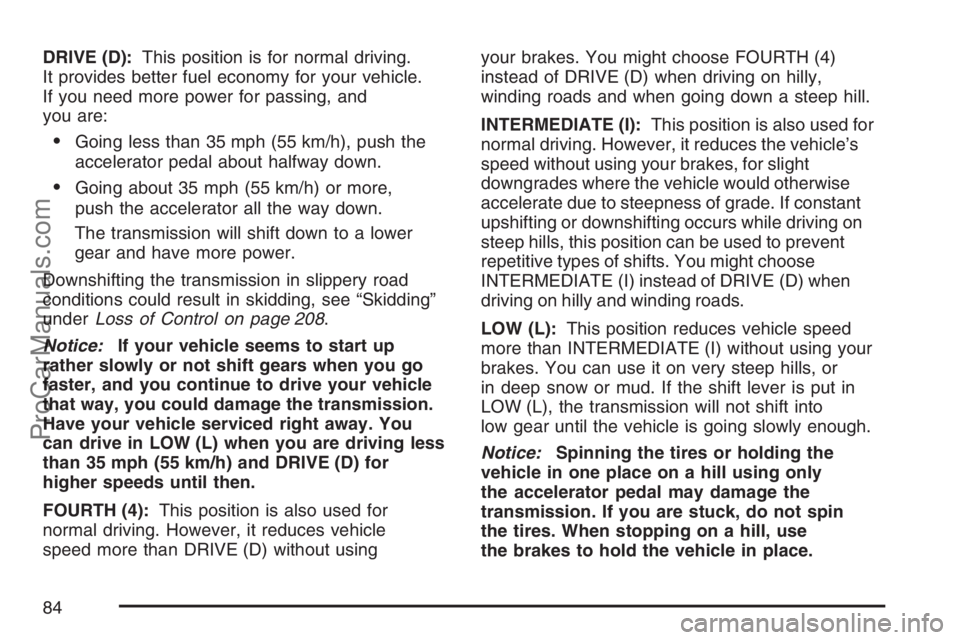
DRIVE (D):This position is for normal driving.
It provides better fuel economy for your vehicle.
If you need more power for passing, and
you are:
Going less than 35 mph (55 km/h), push the
accelerator pedal about halfway down.
Going about 35 mph (55 km/h) or more,
push the accelerator all the way down.
The transmission will shift down to a lower
gear and have more power.
Downshifting the transmission in slippery road
conditions could result in skidding, see “Skidding”
underLoss of Control on page 208.
Notice:If your vehicle seems to start up
rather slowly or not shift gears when you go
faster, and you continue to drive your vehicle
that way, you could damage the transmission.
Have your vehicle serviced right away. You
can drive in LOW (L) when you are driving less
than 35 mph (55 km/h) and DRIVE (D) for
higher speeds until then.
FOURTH (4):This position is also used for
normal driving. However, it reduces vehicle
speed more than DRIVE (D) without usingyour brakes. You might choose FOURTH (4)
instead of DRIVE (D) when driving on hilly,
winding roads and when going down a steep hill.
INTERMEDIATE (I):This position is also used for
normal driving. However, it reduces the vehicle’s
speed without using your brakes, for slight
downgrades where the vehicle would otherwise
accelerate due to steepness of grade. If constant
upshifting or downshifting occurs while driving on
steep hills, this position can be used to prevent
repetitive types of shifts. You might choose
INTERMEDIATE (I) instead of DRIVE (D) when
driving on hilly and winding roads.
LOW (L):This position reduces vehicle speed
more than INTERMEDIATE (I) without using your
brakes. You can use it on very steep hills, or
in deep snow or mud. If the shift lever is put in
LOW (L), the transmission will not shift into
low gear until the vehicle is going slowly enough.
Notice:Spinning the tires or holding the
vehicle in one place on a hill using only
the accelerator pedal may damage the
transmission. If you are stuck, do not spin
the tires. When stopping on a hill, use
the brakes to hold the vehicle in place.
84
ProCarManuals.com
Page 86 of 384
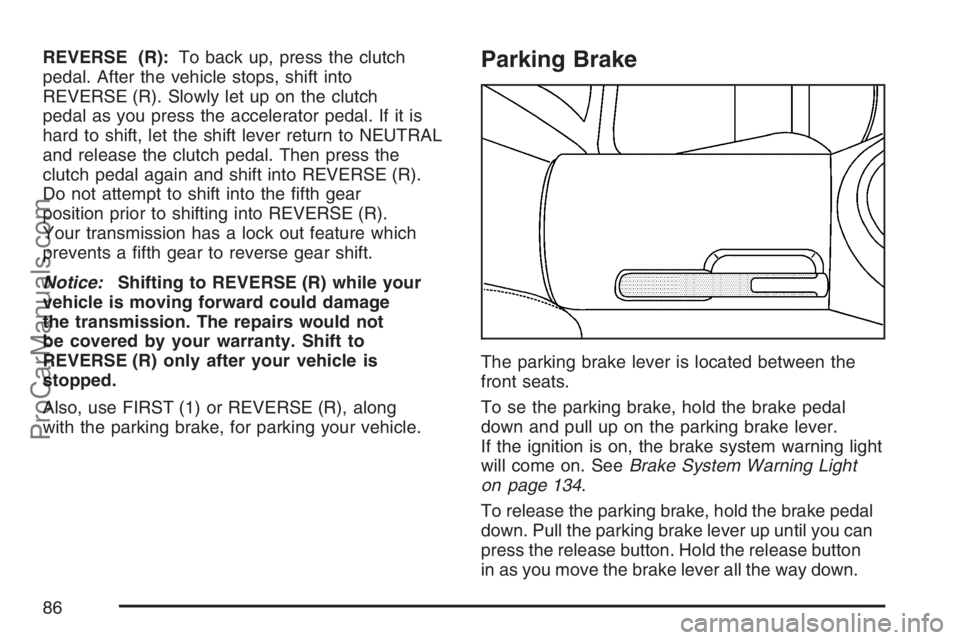
REVERSE (R):To back up, press the clutch
pedal. After the vehicle stops, shift into
REVERSE (R). Slowly let up on the clutch
pedal as you press the accelerator pedal. If it is
hard to shift, let the shift lever return to NEUTRAL
and release the clutch pedal. Then press the
clutch pedal again and shift into REVERSE (R).
Do not attempt to shift into the �fth gear
position prior to shifting into REVERSE (R).
Your transmission has a lock out feature which
prevents a �fth gear to reverse gear shift.
Notice:Shifting to REVERSE (R) while your
vehicle is moving forward could damage
the transmission. The repairs would not
be covered by your warranty. Shift to
REVERSE (R) only after your vehicle is
stopped.
Also, use FIRST (1) or REVERSE (R), along
with the parking brake, for parking your vehicle.Parking Brake
The parking brake lever is located between the
front seats.
To se the parking brake, hold the brake pedal
down and pull up on the parking brake lever.
If the ignition is on, the brake system warning light
will come on. SeeBrake System Warning Light
on page 134.
To release the parking brake, hold the brake pedal
down. Pull the parking brake lever up until you can
press the release button. Hold the release button
in as you move the brake lever all the way down.
86
ProCarManuals.com
Page 87 of 384
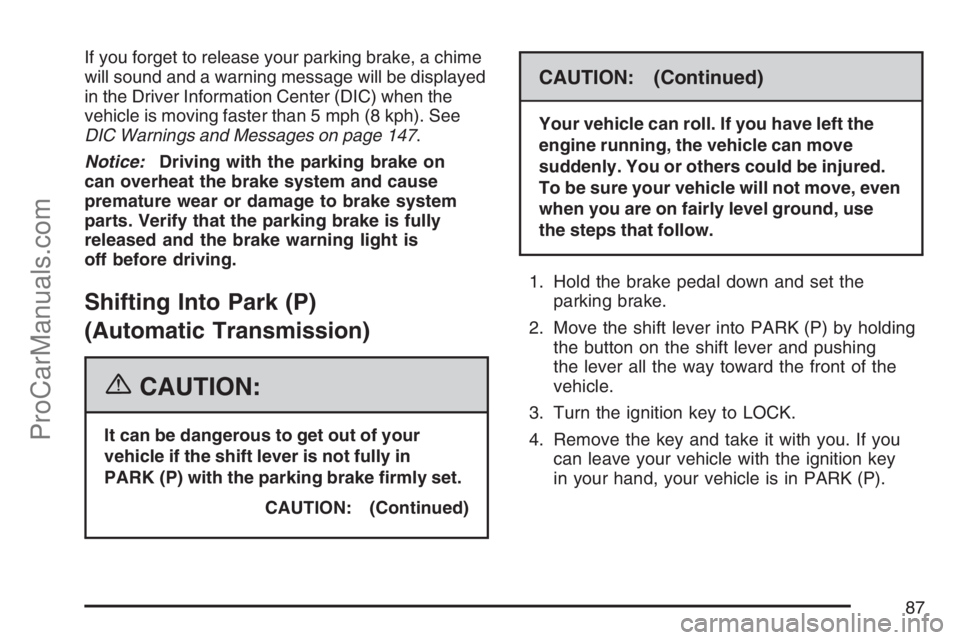
If you forget to release your parking brake, a chime
will sound and a warning message will be displayed
in the Driver Information Center (DIC) when the
vehicle is moving faster than 5 mph (8 kph). See
DIC Warnings and Messages on page 147.
Notice:Driving with the parking brake on
can overheat the brake system and cause
premature wear or damage to brake system
parts. Verify that the parking brake is fully
released and the brake warning light is
off before driving.
Shifting Into Park (P)
(Automatic Transmission)
{CAUTION:
It can be dangerous to get out of your
vehicle if the shift lever is not fully in
PARK (P) with the parking brake �rmly set.
CAUTION: (Continued)
CAUTION: (Continued)
Your vehicle can roll. If you have left the
engine running, the vehicle can move
suddenly. You or others could be injured.
To be sure your vehicle will not move, even
when you are on fairly level ground, use
the steps that follow.
1. Hold the brake pedal down and set the
parking brake.
2. Move the shift lever into PARK (P) by holding
the button on the shift lever and pushing
the lever all the way toward the front of the
vehicle.
3. Turn the ignition key to LOCK.
4. Remove the key and take it with you. If you
can leave your vehicle with the ignition key
in your hand, your vehicle is in PARK (P).
87
ProCarManuals.com